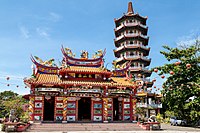Deities Sanxing
The Sanxing (三星; sānxīng; 'Three Stars') are the gods of the three celestial bodies considered essential in Chinese astrology and mythology: Jupiter, Ursa Major, and Canopus.
This article needs additional citations for verification. (August 2017) |
Fu, Lu, and Shou (traditional Chinese: 福祿壽; simplified Chinese: 福禄寿; pinyin: Fú Lù Shòu; Cantonese Yale: Fūk Luhk Sauh), or Cai, Zi and Shou (財子壽) are also the embodiments of Fortune (Fu), presiding over the planet Jupiter, Prosperity (Lu), presiding over Mizar, and Longevity (Shou), presiding over Canopus. They have emerged from Chinese folk religion. Their iconic representation as three, old, bearded, wise men dates back to the Ming dynasty, when the gods of the three stars were represented in human form for the first time. They are sometimes identified with other deities of the Chinese religion or of Taoism.
| Sanxing | |||||||||||||||||
|---|---|---|---|---|---|---|---|---|---|---|---|---|---|---|---|---|---|
 | |||||||||||||||||
| Chinese name | |||||||||||||||||
| Traditional Chinese | 福祿壽 | ||||||||||||||||
| Simplified Chinese | 福禄寿 | ||||||||||||||||
| |||||||||||||||||
| Vietnamese name | |||||||||||||||||
| Vietnamese alphabet | Phúc Lộc Thọ | ||||||||||||||||
| Chữ Hán | 福祿壽 | ||||||||||||||||
| Japanese name | |||||||||||||||||
| Kanji | 福禄寿 | ||||||||||||||||
| |||||||||||||||||
The term is commonly used in Chinese culture to denote the three attributes of a good life. Statues of these three gods are found on the facades of folk religion's temples and ancestral shrines, in nearly every Chinese home and many Chinese-owned shops on small altars with a glass of water, an orange or other auspicious offerings, especially during Chinese New Year. Traditionally, they are arranged right to left (so Shou is on the left of the viewer, Lu in the middle, and Fu on the far right), just as Chinese characters are traditionally written from right to left.
The three gods, their stars and their attributes
Fuxing

The star of Fu (福), Fuxing 福星, refers to the planet Jupiter. In traditional astrology, the planet Jupiter was believed to be auspicious. Alternatively, according to a Taoist myth of the Ming dynasty, the Fu star is associated with Yang Cheng (楊成), a governor of Daozhou in the Tang dynasty. Yang Cheng risked his life by writing a memorial to the emperor to save the people from presenting dwarf slaves as the special tribute to the imperial court. After his death, the people built a temple to commemorate him, and over time he came to be considered the personification of good fortune.
He is generally depicted in scholar's dress, holding a scroll, on which is sometimes written the character "Fu". He may also be seen holding a child, or surrounded by children. He is sometimes conflated with Caishen, the "Wealth God".
Luxing
The star of Lu (祿), Luxing 祿星, is Mizar (ζ Ursa Majoris), or, in traditional Chinese astronomy, the sixth star in the Wenchang cluster, and like the Fu star came to be personified.[citation needed] The Lu star is believed to be Zhang Xian who lived during the Later Shu dynasty. The word lu specifically refers to the salary of a government official. As such, the Lu star is the star of prosperity, rank, and influence.
The Lu star was also worshipped separately from the other two as the deity dictating one's success in the imperial examinations, and therefore success in the imperial bureaucracy. The Lu star is usually depicted in the dress of a mandarin.
Shouxing
The star of Shou (壽), Shouxing 壽星, is α Carinae (Canopus), the star of the south pole in Chinese astronomy, and is believed to control the life spans of mortals. According to legend, he was carried in his mother's womb for ten years before being born, and was already an old man when delivered. He is recognized by his high, domed forehead and the peach which he carries as a symbol of immortality. The longevity god is usually shown smiling and friendly, and he may sometimes be carrying a gourd filled with the elixir of life. He is sometimes conflated with Master Lao and corresponding gods of Taoist theology.
Gallery
- Fu, Lu and Shou statues on the roof of Ling San Temple, a Chinese folk religion's temple in Tuaran, Sabah, Malaysia
- A street altar with Fu, Lu and Shou statues during Chinese New Year 2015 in Paris, France
- This shrine to a Master Yong in a Yangxin County village, Hubei features a tablet, high in the facade, saying "The Three Stars are Present". The symbol at the top of the facade is a stylised derivation of the character shou , "longevity"
See also
- Fukurokuju, Japanese god derived from "Shou" deity of Sanxing
- He-He Er Xian (和合二仙), Immortals of Harmony and Union, associated with happy marriages
- Seven Lucky Gods, similar group of Japanese auspicious deities
- Tai Sui (太歲)—60 Heavenly Officials who will be in charge of each year during the Chinese sixty-year cycle
- Wufang Shangdi
References
- Seow, Jeffrey. Fu Lu Shou: Gods of Blessings, Prosperity and Longevity, Singapore, 1999.
External links
 Media related to Fu Lu Shou at Wiki Commons
Media related to Fu Lu Shou at Wiki Commons
This article uses material from the Wikipedia English article Sanxing (deities), which is released under the Creative Commons Attribution-ShareAlike 3.0 license ("CC BY-SA 3.0"); additional terms may apply (view authors). Content is available under CC BY-SA 4.0 unless otherwise noted. Images, videos and audio are available under their respective licenses.
®Wikipedia is a registered trademark of the Wiki Foundation, Inc. Wiki English (DUHOCTRUNGQUOC.VN) is an independent company and has no affiliation with Wiki Foundation.











